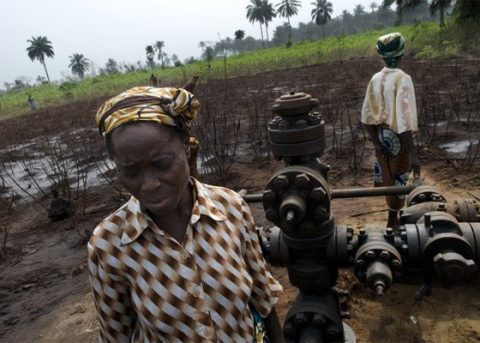
Human Rights Groups Task Shell And ENI On Kyoto, Threatens Shutdown
The Human & Environmental Rights Dynamic Advocacy Development Initiative -a Non-governmental Organization in collaboration with other local and international human and environmental rights bodies, have concluded plans to sue the Shell Petroleum Development Company and the Eni Group, particularly the Nigerian Agip Oil Company, NAOC at the Hague in the Netherlands for aggravated environmental offences pertaining to gas flaring and other offences verging on environmental degradation. Today, the Niger Delta suffers environmental terrorism with its attendant biodiversity loss, environmental pollution, coastal erosion, effect on human health, crops, fishes and other marine resources.
HERDADI has discovered that since these companies started their operations of oil exploration and exploitation, gas flaring has not abated. Although there had been consensus on when to stop gas flaring in the past three decades, the oil multinationals have continued to shift the goal post. Attempts made to reduce gas flaring and the emission of green house gases have failed. One of such efforts was the Kyoto Protocol.
The Kyoto Protocol:
The Kyoto Protocol is an international agreement linked to the United Nations Framework Conventionon Climate Change. The major feature of the Kyoto Protocol is that it sets binding targets for 37industrialised countries and the European community for reducing greenhouse gas (GHG) emissions.
These amount to an average of five per cent against 1990 levels over the five-year period 2008-2012.
Recognising that developed countries are principally responsible for the current high levels of GHGemissions in the atmosphere as a result of more than 150 years of industrial activity, the Protocolplaces a heavier burden on developed nations under the principle of “common but differentiatedresponsibilities
The Kyoto Protocol was adopted in Kyoto, Japan, on 11 December 1997 and entered into force on 16February 2005. The detailed rules for the implementation of the Protocol were adopted at COP 7 inMarrakesh in 2001, and are called the “Marrakesh Accords.”
Under the Treaty, countries must meet their targets primarily through national measures. However,the Kyoto Protocol offers them an additional means of meeting their targets by way of threemarket-based mechanisms.
Under the Protocol , countries’actual emissions have to be monitored and precise records have to bekept of the trades carried out.
Registry systems track and record transactions by Parties under the mechanisms. The UN ClimateChange Secretariat, based in Bonn, Germany, keeps an international transaction log to verify thattransactions are consistent with the rules of the Protocol.
A compliance system ensures that Parties are meeting their commitments and helps them to meettheir commitments if they have problems doing so.The Kyoto Protocol , like the Convention, is also designed to assist countries in adapting to the adverseeffects of climate change. It facilitates the development and deployment of techniques that can helpincrease resilience to the impacts of climate change.
The Adaptation Fund was established to finance adaptation projects and programmes in developingcountries that are Parties to the Kyoto Protocol. The Fund is financed mainly through a share ofproceeds from CDM project activities.
The targets cover emissions of the six main greenhouse gases, namely:
Carbon dioxide (CO );
Methane (CH );
Nitrous oxide (N O);
Hydrofluorocarbons (HFCs);
Perfluorocarbons (PFCs); and
Sulphur hexafluoride (SF )
The maximum amount of emissions (measured as the equivalent in carbon dioxide) that a Party may emit over the commitment period in order to comply with its emissions target is known as a Party’s assigned amount.
The 15 States that were EU members in 1997 when the Kyoto Protocol was adopted, agreed that the8% target that will be redistributed among themselves, taking advantage of a scheme under theProtocol known as a “bubble”, whereby countries have different individual targets, but which combinedmake an overall target for that group of countries. The EU has already reached agreement on how its targets will be redistributed.
1. Some Economies in Transition have a baseline other than 1990.Those baselines will be spelt out and followed through.
2. The US has indicated its intention not to ratify the Kyoto Protocol.This is in bad faith.
The Protocol mirrors the Convention in recognising the specific needs and concerns of developing countries, especially the most vulnerable among them. In Nigeria, the most vulnerable.
An Adaptation Fund was established to finance concrete adaptation projects and programmes in
developing countries that are Parties to the Kyoto Protocol. The Fund is to be financed with a share of proceeds from clean development mechanism (CDM) project activities and receive funds from other sources.
The Convention took effect in 1994, and by 1995 governments had begun negotiations on a protocol — an international agreement linked to the existing treaty, but standing on its own. The text of the Kyoto Protocol was adopted unanimously in 1997; it entered into force on 16 February 2005.
The Protocol’s major feature is that it has mandatory targets on greenhouse-gas emissions for the world’s leading economies which have accepted it . These targets range from -8 per cent to +10 per cent of the countries’ individual 1990 emissions levels “with a view to reducing their overall emissions of such gases by at least 5 per cent below existing 1990 levels in the commitment period 2008 to 2012.”These conditions have not been met by the Oil Multinationals.
In almost all cases — even those set at +10 per cent of 1990 levels — the limits call for significant reductions in currently projected emissions. Future mandatory targets are expected to be established for “commitment periods” after 2012. These are to be negotiated well in advance of the periods
concerned.
Commitments under the Protocol vary from nation to nation. The overall 5 per cent target for developed countries is to be met through cuts (from 1990 levels) of 8 per cent in the European Union (EU, Switzerland, and most Central and East European states; 6 per cent in Canada; 7 per cent in the United States (although the US has since withdrawn its support for the Protocol); and 6 per cent in Hungary, Japan, and Poland. New Zealand, Russia, and Ukraine are to stabilize their emissions, while Norway may increase emissions by up to 1 per cent, Australia by up to 8 per cent (subsequently withdrew its support for the Protocol), and Iceland by 10 per cent. The EU has made its own internal agrement to meet its 8 per cent target by distributing different rates to its member states. These targets range from a 28 per cent reduction by Luxembourg and 21 per cent cuts by Denmark and Germany to a 25 per cent increase by Greece and a 27 per cent increase by Portugal.
To compensate for the sting of “binding targets,” as they are called, the agreement offers flexibility in how countries may meet their targets . For example, they may partially compensate for their emissions by increasing “sinks” — forests, which remove carbon dioxide from the atmosphere.
That may be accomplished either on their own territories or in other countries. Or they may pay for foreign projects that result in greenhouse-gas cuts. Several mechanisms have been set up for this purpose.
The Kyoto Protocol is a complicated agreement that has been slow in coming–there are reasons for this. The Protocol not only has to be an effective against a complicated worldwide problem — it also has to be politically acceptable. As a result, panels and committees have multiplied to monitor and referee its various programmes, and even after the agreement was approved in 1997, further negotiations were deemed necessary to hammer out instructions on how to “operate” it. These rules, adopted in 2001, are called the “Marrakesh Accords.”
There is a delicate balance to international treaties. Those appealing enough to gain widespread support often aren’t strong enough to solve the problems they focus on. (Because the FrameworkConvention was judged to have this weakness, despite its many valuable provisions, the Protocol was created to supplement it.) Yet treaties with real “teeth” may have difficulty attracting enoughwidespread support to be effective.
Some mechanisms of the Protocol had enough support that they were set up in advance of the
Protocol’s entry into force . The Clean Development Mechanism, for example — through which industrialized countries can partly meet their binding emissions targets through “credits” earned by sponsoring greenhouse-gas-reducing projects in developing countries — already had an executive board before the Kyoto Protocol entered into force on 16 February 2005.
HERDADI seeks a definite deadline for the stoppage of greenhouse gases especially via gas flaring. This implies adherence to the Kyoto Protocol. Further, HERDADI demands the sum of $100 billion for the remediation of the Niger Delta Environmental, which has been utterly destroyed by the MNCs especially SPDC and the Eni Group. HERDADI and her coalition NGOs will stop at nothing until these conditions are fulfilled. Finally, all industrialized nations that fail to adhere to the Kyoto regime shall be penalized by paying a fine of $5 billion anually.
Failure to meet these conditions may led to the complete shut down of all oil exploration and exploitation activities in the Niger Delta Region of Nigeria. HERDADI and her coalitions will follow the legal process through to realize it’s objectives.
President, HERDADI


